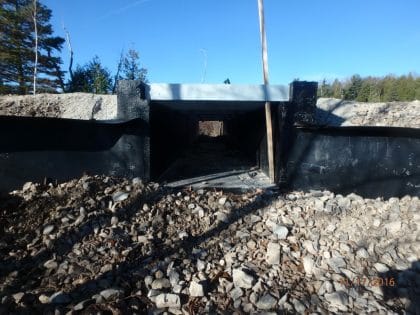Designing Mitigation Systems
Wildlife mitigation systems on roads include safe wildlife crossing opportunities and exclusionary fencing. Fencing reduces road-kill and funnels animals to wildlife crossings. Wildlife crossings include existing infrastructures such as drainage culverts, and bridges, or ‘dedicated’ wildlife crossings that are built into new road upgrade or extension projects. Other components of the system include fence-end treatments, one-way gates, and jump outs. Eco-Kare specializes in keeping up to date with Best Management Practices and Techniques for designing mitigation systems.
Services include:

I. Designing wildlife crossing structures for target species;
- Integrate existing landscape, hydraulic, and road features into crossing structure plan;
- Provide optimal spacing and placement of crossings;
- Work with engineers and hydrologists to understand limitations and feasibility of implementation.
II. Designing a wildlife exclusionary fencing package – both temporary and permanent – that meets project objectives and budget for target species; Fencing package includes all and or some of the components below:
- Obtaining best price of fencing materials that meet project budgets;
- On-site visit to assess fencing needs (temporary: 1-5 years; permanent: >5 years);
- Assessment of site conditions landscape, e.g. drainage ditches and road features, e.g. guide-rails for best fence placement that considers drainage;
- Placement and design of functional fencing that spans habitat, and provides opportunities for safe wildlife crossings if possible;
- Fence end, Jump Out and One-way gate design and placement.
- Oversee and installation services for wildlife exclusion fencing along roadsides;
- Installation method that meets project objectives;
- Installation of entire project or work with contractors and engineers to oversee installation;
- Installation specialization includes connecting fencing to underpasses at entrances and in medians, jump-outs, and fence-end treatments.
- Inclusion of techniques at drainage culverts that both allow wildlife passage, exclusion of beavers and subsequent functionality of culverts for water flow;
- Road survey monitoring techniques (wildlife road surveys) for evaluating exclusionarly fencing system effectiveness.
You can see some specific implementation projects below:
Eastern Ontario | Kouchibouguac National Park | Bruce Peninsula
Highway 69 | Outer Drive | Highway 48